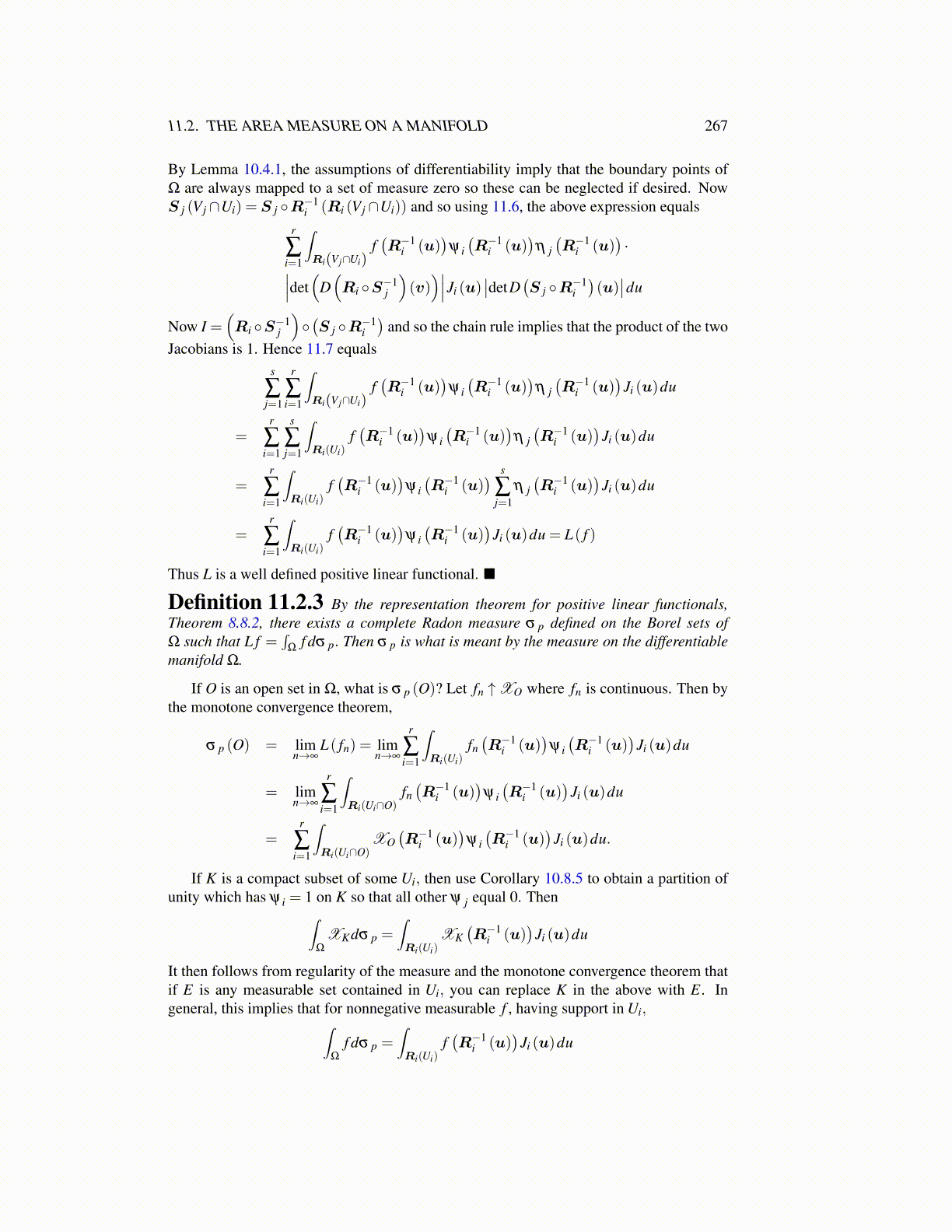
11.2. THE AREA MEASURE ON A MANIFOLD 267
By Lemma 10.4.1, the assumptions of differentiability imply that the boundary points ofΩ are always mapped to a set of measure zero so these can be neglected if desired. NowS j (Vj ∩Ui) = S j ◦R−1
i (Ri (Vj ∩Ui)) and so using 11.6, the above expression equalsr
∑i=1
∫Ri(V j∩Ui)
f(R−1
i (u))
ψ i(R−1
i (u))
η j(R−1
i (u))·∣∣∣det
(D(Ri ◦S−1
j
)(v))∣∣∣Ji (u)
∣∣detD(S j ◦R−1
i)(u)∣∣du
Now I =(Ri ◦S−1
j
)◦(S j ◦R−1
i
)and so the chain rule implies that the product of the two
Jacobians is 1. Hence 11.7 equalss
∑j=1
r
∑i=1
∫Ri(V j∩Ui)
f(R−1
i (u))
ψ i(R−1
i (u))
η j(R−1
i (u))
Ji (u)du
=r
∑i=1
s
∑j=1
∫Ri(Ui)
f(R−1
i (u))
ψ i(R−1
i (u))
η j(R−1
i (u))
Ji (u)du
=r
∑i=1
∫Ri(Ui)
f(R−1
i (u))
ψ i(R−1
i (u)) s
∑j=1
η j(R−1
i (u))
Ji (u)du
=r
∑i=1
∫Ri(Ui)
f(R−1
i (u))
ψ i(R−1
i (u))
Ji (u)du = L( f )
Thus L is a well defined positive linear functional. ■
Definition 11.2.3 By the representation theorem for positive linear functionals,Theorem 8.8.2, there exists a complete Radon measure σ p defined on the Borel sets ofΩ such that L f =
∫Ω
f dσ p. Then σ p is what is meant by the measure on the differentiablemanifold Ω.
If O is an open set in Ω, what is σ p (O)? Let fn ↑XO where fn is continuous. Then bythe monotone convergence theorem,
σ p (O) = limn→∞
L( fn) = limn→∞
r
∑i=1
∫Ri(Ui)
fn(R−1
i (u))
ψ i(R−1
i (u))
Ji (u)du
= limn→∞
r
∑i=1
∫Ri(Ui∩O)
fn(R−1
i (u))
ψ i(R−1
i (u))
Ji (u)du
=r
∑i=1
∫Ri(Ui∩O)
XO(R−1
i (u))
ψ i(R−1
i (u))
Ji (u)du.
If K is a compact subset of some Ui, then use Corollary 10.8.5 to obtain a partition ofunity which has ψ i = 1 on K so that all other ψ j equal 0. Then∫
Ω
XKdσ p =∫Ri(Ui)
XK(R−1
i (u))
Ji (u)du
It then follows from regularity of the measure and the monotone convergence theorem thatif E is any measurable set contained in Ui, you can replace K in the above with E. Ingeneral, this implies that for nonnegative measurable f , having support in Ui,∫
Ω
f dσ p =∫Ri(Ui)
f(R−1
i (u))
Ji (u)du